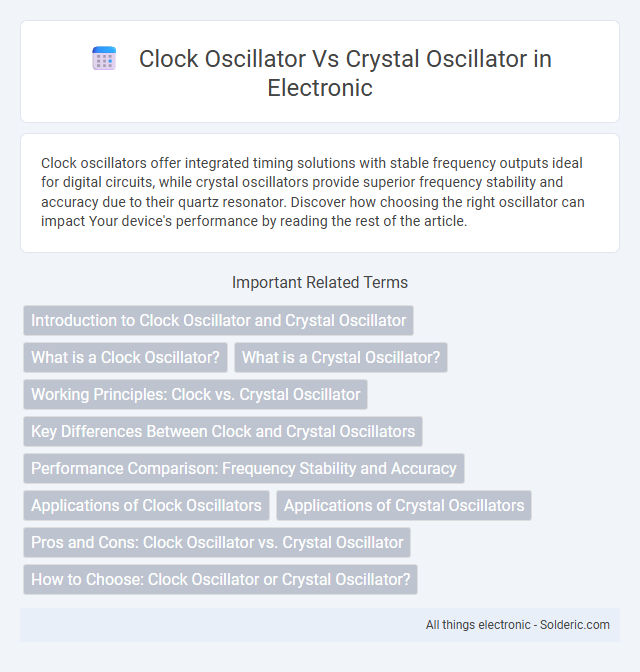Clock oscillators offer integrated timing solutions with stable frequency outputs ideal for digital circuits, while crystal oscillators provide superior frequency stability and accuracy due to their quartz resonator. Discover how choosing the right oscillator can impact Your device's performance by reading the rest of the article.
Comparison Table
| Feature | Clock Oscillator | Crystal Oscillator |
|---|---|---|
| Frequency Stability | Moderate | High |
| Frequency Accuracy | +-0.1% to 1% | +-10 ppm to 50 ppm |
| Typical Frequencies | 1 kHz to 100 MHz | 1 MHz to 200 MHz |
| Temperature Sensitivity | Higher | Lower |
| Cost | Lower | Higher |
| Size | Smaller | Varies (typically larger) |
| Power Consumption | Low to Moderate | Low |
| Applications | Microcontrollers, clocks, basic timing | Precision timing, communication systems, sensors |
| Output Signal | Square wave | Sine wave (usually shaped to square) |
Introduction to Clock Oscillator and Crystal Oscillator
Clock oscillators generate precise timing signals using an integrated circuit combined with a resonator, providing stable and reliable clock pulses for digital devices. Crystal oscillators utilize a quartz crystal as the resonator, exploiting its piezoelectric properties to produce highly accurate and consistent frequencies essential for microcontrollers, communication systems, and frequency synthesis. Your choice between clock and crystal oscillators depends on the required frequency stability, size constraints, and application-specific accuracy.
What is a Clock Oscillator?
A Clock oscillator is an electronic circuit that generates a consistent and precise clock signal used to synchronize the operations of digital systems. It produces a square wave output at a fixed frequency, essential for timing in microprocessors, communication devices, and other digital electronics. Your choice of a clock oscillator impacts the stability and accuracy of the system's timing performance.
What is a Crystal Oscillator?
A crystal oscillator is an electronic oscillator circuit that uses the mechanical resonance of a vibrating quartz crystal to create an accurate frequency signal. It provides high precision and stability compared to a clock oscillator, making it essential in devices requiring precise timing such as watches, radios, and computers. The quartz crystal's piezoelectric properties allow it to maintain a consistent oscillation frequency, minimizing drift and temperature variations.
Working Principles: Clock vs. Crystal Oscillator
Clock oscillators generate precise timing signals using an electronic circuit with a resonant frequency set by an external crystal or LC circuit, while crystal oscillators rely on the piezoelectric effect of quartz crystals to maintain a stable frequency. The quartz crystal in a crystal oscillator vibrates at a natural resonant frequency when voltage is applied, producing highly accurate and stable oscillations. Your choice depends on the required frequency stability, with crystal oscillators offering superior precision compared to standard clock oscillators.
Key Differences Between Clock and Crystal Oscillators
Clock oscillators provide a stable clock signal using an integrated circuit, while crystal oscillators use a quartz crystal to generate precise frequency through mechanical resonance. Crystal oscillators typically offer higher frequency stability and accuracy, making them preferred in applications requiring precise timing, whereas clock oscillators are more versatile with easier integration. The key difference lies in the frequency control element: quartz crystal in crystal oscillators versus an electronic circuit in clock oscillators.
Performance Comparison: Frequency Stability and Accuracy
Crystal oscillators offer superior frequency stability and accuracy compared to clock oscillators due to their precise quartz crystal resonators, which maintain consistent oscillation frequencies under varying environmental conditions. Clock oscillators, often based on RC or LC circuits, exhibit greater frequency drift influenced by temperature fluctuations and aging. Choosing a crystal oscillator enhances Your system's timing precision, essential for applications demanding high-performance frequency control.
Applications of Clock Oscillators
Clock oscillators are widely used in microcontrollers, digital watches, and communication equipment to provide a stable timing reference for synchronous operations. They generate precise clock signals essential for data transfer, control timing, and system synchronization in embedded systems and computer processors. In contrast to crystal oscillators, clock oscillators often integrate frequency control and output signal conditioning, making them suitable for applications requiring ease of use and compact design.
Applications of Crystal Oscillators
Crystal oscillators are widely used in applications requiring high precision and stability, such as in clocks, radios, and microcontrollers for accurate timing and frequency control. They provide a consistent oscillation frequency essential in communication devices, GPS systems, and digital watches to ensure synchronized operation. Your choice of a crystal oscillator improves the reliability and accuracy of electronic circuits in servers, mobile phones, and instrumentation equipment.
Pros and Cons: Clock Oscillator vs. Crystal Oscillator
Clock oscillators offer ease of use and integrated circuitry, providing consistent frequency outputs ideal for digital circuits, but they generally consume more power and may have less frequency stability compared to crystal oscillators. Crystal oscillators provide superior frequency accuracy and stability due to the piezoelectric properties of quartz, making them perfect for precise timing applications, though they tend to be more sensitive to temperature changes and require additional circuitry for operation. Your choice depends on the balance between accuracy and power consumption required by your specific application.
How to Choose: Clock Oscillator or Crystal Oscillator?
Selecting between a clock oscillator and a crystal oscillator depends on factors such as frequency stability, accuracy, and application requirements. Clock oscillators provide integrated frequency sources with lower external component count and are ideal for systems needing simplified design and moderate precision. Crystal oscillators offer superior frequency stability and precision, essential for applications demanding high accuracy and low phase noise, like communication and timing circuits.
Clock oscillator vs Crystal oscillator Infographic

 solderic.com
solderic.com